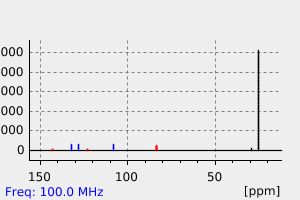3,6-di-(4,4,5,5-tetramethyl-1,3,2-dioxaborolan-2-yl)-9-methylcarbazole | 628336-96-9
中文名称
——
中文别名
——
英文名称
3,6-di-(4,4,5,5-tetramethyl-1,3,2-dioxaborolan-2-yl)-9-methylcarbazole
英文别名
9-methyl-3,6-bis(4,4,5,5-tetramethyl[1,3,2]dioxaborolan-2-yl)-9H-carbazole;9-Methyl-3,6-bis(4,4,5,5-tetramethyl-1,3,2-dioxaborolan-2-yl)-9H-carbazole;9-methyl-3,6-bis(4,4,5,5-tetramethyl-1,3,2-dioxaborolan-2-yl)carbazole
CAS
628336-96-9
化学式
C25H33B2NO4
mdl
——
分子量
433.163
InChiKey
IBJJFDFQDBNABM-UHFFFAOYSA-N
BEILSTEIN
——
EINECS
——
-
物化性质
-
计算性质
-
ADMET
-
安全信息
-
SDS
-
制备方法与用途
-
上下游信息
-
文献信息
-
表征谱图
-
同类化合物
-
相关功能分类
-
相关结构分类
物化性质
-
沸点:532.4±43.0 °C(Predicted)
-
密度:1.10±0.1 g/cm3(Predicted)
计算性质
-
辛醇/水分配系数(LogP):3.93
-
重原子数:32
-
可旋转键数:2
-
环数:5.0
-
sp3杂化的碳原子比例:0.52
-
拓扑面积:41.8
-
氢给体数:0
-
氢受体数:4
反应信息
-
作为反应物:描述:3,6-di-(4,4,5,5-tetramethyl-1,3,2-dioxaborolan-2-yl)-9-methylcarbazole 、 4-bromo-N-(2-ethylhexyl)-1,8-naphthalimide 在 bis-triphenylphosphine-palladium(II) chloride 、 potassium carbonate 作用下, 以 四氢呋喃 、 水 为溶剂, 反应 24.0h, 以66%的产率得到3,6-di((N-(2-ethylhexyl)-1,8-naphthalimide)-4-yl)-9-methyl-9H-carbazole参考文献:名称:咔唑和1,8-萘二甲酰亚胺衍生物的结构-性质关系:取代和连接拓扑的影响摘要:利用钯催化的C-N和CC偶联反应,合成了九种具有电子接受性1,8-萘二甲酰亚胺和给电子咔唑基团的化合物,并通过热方法,吸收和发射光谱,电化学和光电工具进行了表征。合成的化合物具有很高的热稳定性,5%的失重温度在351–476°C的范围内。大多数合成的化合物都能够在30到87°C的玻璃化转变温度下形成玻璃。循环伏安法测量表明,咔唑和1,8-萘二甲酰亚胺衍生物的固态电离电势值范围为5.46 eV至5.76 eV,电子亲和力值范围为-3.04 eV至-2.92 eV。3和3的稀释溶液,发现在极性溶剂中咔唑的6-萘二甲酰亚胺取代的衍生物在绿色区域发射,量子产率范围为0.66至0.83,而在固态荧光量子产率范围为0.01-0.45。((E)-9-(((N-(2-乙基己基)-1,8-萘二甲酰亚胺)-4-基)乙烯基)-9 H-咔唑)在固态下显示出有效的荧光,量子产率高达0.45。分析了生色团的连接拓扑结DOI:10.1016/j.dyepig.2014.11.013
-
作为产物:描述:N-甲基咔唑 在 aluminum (III) chloride 、 三氯化硼 、 三乙胺 、 N,N-二甲基对甲苯胺 作用下, 以 二氯甲烷 为溶剂, 反应 16.75h, 生成 3,6-di-(4,4,5,5-tetramethyl-1,3,2-dioxaborolan-2-yl)-9-methylcarbazole参考文献:名称:Simple inexpensive boron electrophiles for direct arene borylation摘要:使用由廉价试剂(特别是胺、三氯化硼(BCl3)和三氯化铝(AlCl3))生成的亲电子试剂,可以促进亲电子直接硼化反应,并扩大芳烃底物的适用范围。DOI:10.1039/c1cc14226g
文献信息
-
Mechanistic Studies into Amine-Mediated Electrophilic Arene Borylation and Its Application in MIDA Boronate Synthesis作者:Viktor Bagutski、Alessandro Del Grosso、Josue Ayuso Carrillo、Ian A. Cade、Matthew D. Helm、James R. Lawson、Paul J. Singleton、Sophia A. Solomon、Tommaso Marcelli、Michael J. InglesonDOI:10.1021/ja3100963日期:2013.1.9computational study, the borylation of activated arenes at 20 °C proceeds through an S(E)Ar mechanism with borenium cations, [Y(2)B(amine)](+), the key electrophiles. For catecholato-borocations, two amine dependent reaction pathways were identified: (i) With [CatB(NEt(3))](+), an additional base is necessary to accomplish rapid borylation by deprotonation of the borylated arenium cation (σ complex), which otherwise使用 Y(2)BCl (Y(2) = Cl(2) 或邻儿茶酚) 与等摩尔 AlCl(3) 和叔胺直接亲电硼化已应用于广泛的芳烃和杂芳烃。使用 TMS(2)MIDA 可以对 ArBCl(2) 产品进行原位功能化,以中等至良好的产率提供工作台稳定且易于分离的 MIDA 硼酸盐。根据一项联合实验和计算研究,在 20 °C 下活化芳烃的硼酸化通过 S(E)Ar 机制与硼阳离子 [Y(2)B(胺)](+) 进行,这是关键的亲电子试剂。对于儿茶酚 - 硼阳离子,确定了两种胺依赖性反应途径:(i)使用 [CatB(NEt(3))](+),需要额外的碱来通过硼化砷阳离子(σ复合物)的去质子化来实现快速硼化, 否则宁愿分解为起始材料,也不愿释放游离胺以实现去质子化。除了胺之外,额外的碱也可以是芳烃本身,当它足够碱性时(例如,N-Me-吲哚)。(ii) 当硼阳离子的胺组分亲核性较低时(例如,2,6-二甲基吡啶
-
[EN] PROCESS FOR THE BORYLATION OF ARENES AND HETEROARYLS<br/>[FR] PROCÉDÉ DE BORYLATION D'ARÈNES ET D'HÉTÉROARYLES申请人:UNIV MANCHESTER公开号:WO2012025760A1公开(公告)日:2012-03-01This invention relates to a novel process for the borylation of arenes and heteroaryls. The present invention also provides novel borenium cations, which act as electrophiles for electrophilic substitution on the arene or heteroaryl ring, as well as to methodology for the preparation of these cations.
-
Edge‐Decorated Polycyclic Aromatic Hydrocarbons by an Oxidative Coupling Approach作者:Philip Gilmartin、Cassandra Vu、Madeline Rotella、Jasjit Kaur、Marisa KozlowskiDOI:10.1002/chem.202203405日期:2023.2.16Alkoxy highly edge-decorated polycylic aromatic hydrocarbons (PAHs) have been formed. Oxidative cross coupling of phenols constructs frameworks without any need for the prefunctionalization required by conventional methods. Moreover, smaller optical gaps can be achieved relative to systems of similar size.
表征谱图
-
氢谱1HNMR
-
质谱MS
-
碳谱13CNMR
-
红外IR
-
拉曼Raman
-
峰位数据
-
峰位匹配
-
表征信息
同类化合物
(Z)-3-[[[2,4-二甲基-3-(乙氧羰基)吡咯-5-基]亚甲基]吲哚-2--2-
(S)-(-)-5'-苄氧基苯基卡维地洛
(R)-(+)-5'-苄氧基卡维地洛
(R)-卡洛芬
(N-(Boc)-2-吲哚基)二甲基硅烷醇钠
(E)-2-氰基-3-(5-(2-辛基-7-(4-(对甲苯基)-1,2,3,3a,4,8b-六氢环戊[b]吲哚-7-基)-2H-苯并[d][1,2,3]三唑-4-基)噻吩-2-基)丙烯酸
(4aS,9bR)-6-溴-2,3,4,4a,5,9b-六氢-1H-吡啶并[4,3-B]吲哚
(3Z)-3-(1H-咪唑-5-基亚甲基)-5-甲氧基-1H-吲哚-2-酮
(3Z)-3-[[[4-(二甲基氨基)苯基]亚甲基]-1H-吲哚-2-酮
(3R)-(-)-3-(1-甲基吲哚-3-基)丁酸甲酯
(3-氯-4,5-二氢-1,2-恶唑-5-基)(1,3-二氧代-1,3-二氢-2H-异吲哚-2-基)乙酸
齐多美辛
鸭脚树叶碱
鸭脚木碱,鸡骨常山碱
鲜麦得新糖
高氯酸1,1’-二(十六烷基)-3,3,3’,3’-四甲基吲哚碳菁
马鲁司特
马鞭草(VERBENAOFFICINALIS)提取物
马来酸阿洛司琼
马来酸替加色罗
顺式-ent-他达拉非
顺式-1,3,4,4a,5,9b-六氢-2H-吡啶并[4,3-b]吲哚-2-甲酸乙酯
顺式-(+-)-3,4-二氢-8-氯-4'-甲基-4-(甲基氨基)-螺(苯并(cd)吲哚-5(1H),2'(5'H)-呋喃)-5'-酮
靛青二磺酸二钾盐
靛藍四磺酸
靛红联二甲酚
靛红磺酸钠
靛红磺酸
靛红乙烯硫代缩酮
靛红-7-甲酸甲酯
靛红-5-磺酸钠
靛红-5-磺酸
靛红-5-硫酸钠盐二水
靛红-5-甲酸甲酯
靛红
靛玉红衍生物E804
靛玉红3'-单肟5-磺酸
靛玉红-3'-单肟
靛玉红
靛噻
青色素3联己酸染料,钾盐
雷马曲班
雷莫司琼杂质13
雷莫司琼杂质12
雷莫司琼杂质
雷替尼卜定
雄甾-1,4-二烯-3,17-二酮
阿霉素的代谢产物盐酸盐
阿贝卡尔
阿西美辛杂质3







